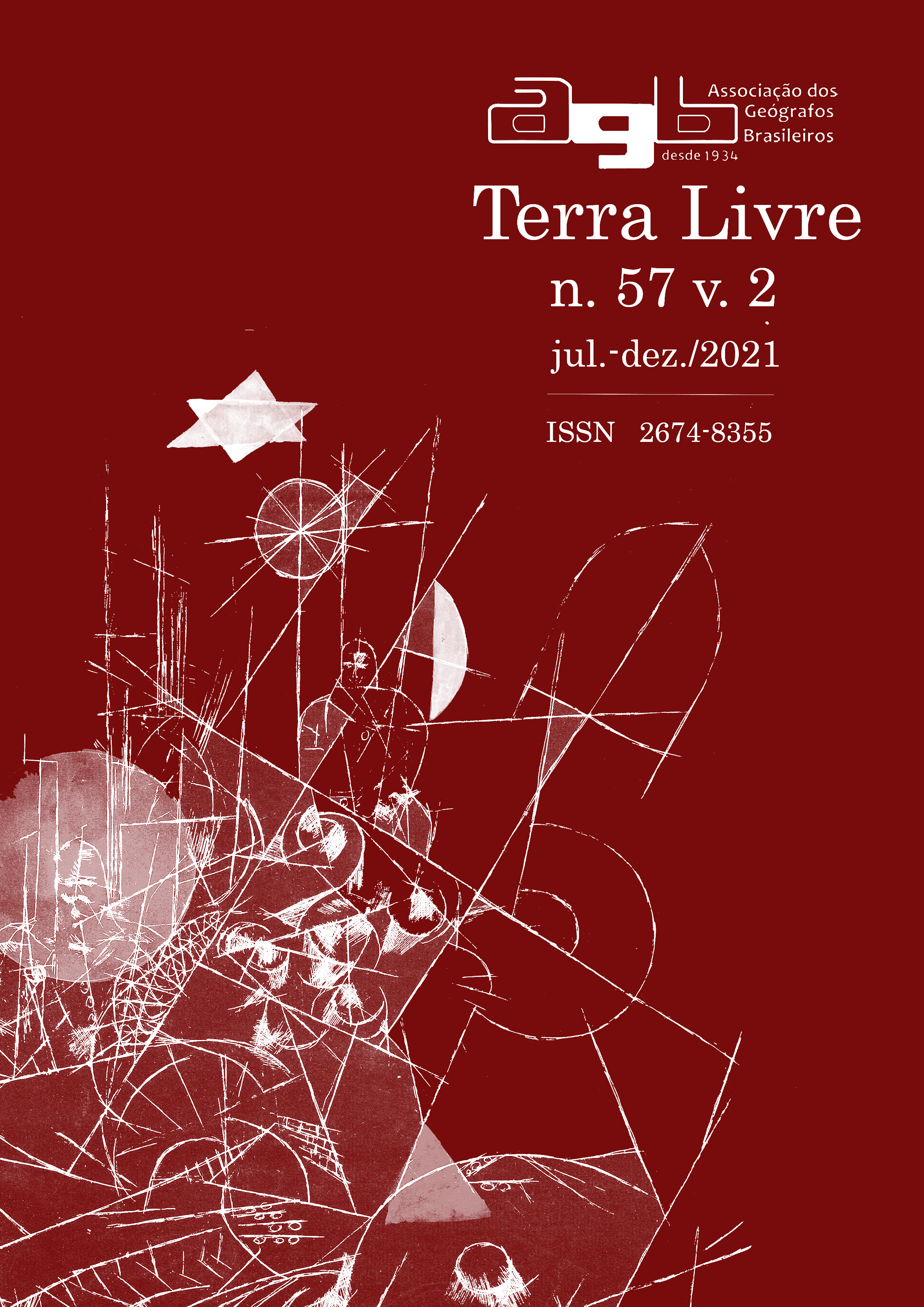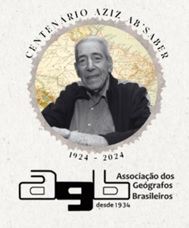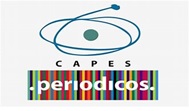THE LENSES OF THE GAZE: A THEORETICAL-METHODOLOGICAL EXERCISE IN THE COMPLEXO VERDE (MA/PA)
um exercício teórico-metodológico no Complexo Verde (MA/PA)
DOI:
https://doi.org/10.62516/terra_livre.2021.2278Keywords:
Land Use and Cover Change, Documentary, Territorial Conflicts, Images, Complexo VerdeAbstract
This paper is about a theoretical-methodological exercise with data integration and epistemologies from differents knowledge fields about land use and cover change and their socio-environmental consequences in the Complexo Verde (MA/PA). The methodology consists of mobilizing qualitative and quantitative techniques to analyze data, which resulted from two types of images: satellite and film images. Thus, such techniques are based on geoprocessing of remote sensing data and film analysis. The results found provide evidence that the proposed theoretical-methodological exercise makes it possible to discuss the socio-environmental processes more complexly, that is, enabling to encompass the plurality of interactions between societies and environments from different epistemological perspectives. Furthermore, it is expected that this article will contribute to the understanding of the socio-environmental dynamics of the region
Downloads
References
ARAÚJO, J. J. Cineastas indígenas, documentário e autoetnografia: um estudo do Projeto Vídeo nas Aldeias. Bragança Paulista: Margem da Palavra, 2019. DOI: https://doi.org/10.34019/2318-101X.2020.v15.30080
AUMONT, J; MARIE, M. A Análise do Filme. Lisboa: Edições Texto & Grafia, 2004.
BARROS, C. No Maranhão cada Guardião da Floresta é um Paulino Guajajara. Agência Pública. 12 de novembro de 2019 Disponível em https://apublica.org/2019/11/no-maranhao-cada-guardiao-da-floresta-e-um-paulino-guajajara/ Acesso em 1º de novembro de 2020.
BRASIL. Decreto nº 87.843 de 22/12/1982. Disponível em: <https://www2.camara.leg.br/legin/fed/decret/1980-1987/decreto-87843-22-novembro-1982-437927-publicacaooriginal-1-pe.html>. Acesso em 17/06/2021.
BRASIL. Diário Oficial da União de 05/10/1993. Disponível em: <https://www.jusbrasil.com.br/diarios/1302419/pg-45-secao-1-diario-oficial-da-uniao-dou-de-05-10-1993>. Acesso em 17/06/2021.
BRITO, T. M. A. de. O cinema, a Geografia e a sala de aula: relato de experiência no estágio docente no colégio técnico da UFMG. Terra Livre, [S. l.], v. 2, n. 53, p. 426–452, 2020. DOI: https://doi.org/10.22533/at.ed.1192026115
CÂMARA, G. Geometrias não são geografias: o legado de Milton Santos. InfoGeo,Curitiba, ano 3, n. 20, 2001
CORMIER, L. A. Kinship with monkeys: The Guajá foragers of Eastern Amazonia. Nova Iorque: Columbia University Press, 2003. DOI: https://doi.org/10.7312/corm12524
CÔRTES, J. C.; SILVA JÚNIOR, R. D. A Interface entre Desmatamento e Urbanização na Amazônia Brasileira. Ambiente e Sociedade (Campinas). v24, 2021.
CORRÊA, R. L. Sobre agentes sociais, escala e produção do espaço: um texto para discussão. In: CARLOS, Ana F.; SOUZA, Marcelo L.; SPOSITO, Maria E. (Orgs.) A produção do espaço urbano: agentes e processos, escalas e desafios. São Paulo: Contexto, 2011. p.41-51
CRESWELL, J.W; PLANO CLARK, V.L. Designing and Conducting Mixed Methods Research. Thousand Oaks, CA: Sage, 2007.
EMBRAPA. TerraClass - Organização, Acesso, Transparência: Amazônia Legal. EMBRAPA Informática Agropecuária. 2020. Disponível em: < https://www.terraclass.gov.br/geoportal-aml/>. Acesso em: 23/06/2021.
FERRO, M. Cinema e História. São Paulo: Ed. Paz e Terra, 1992.
FUNDAÇÃO NACIONAL DO ÍNDIO (FUNAI). Awá Guajá – informações. Disponível em: http://www.funai.gov.br/index.php/informativos/1453-awa-guaja-2?start=1. Acessado em: 17/08/2021
GARCIA, G. J. Sensoriamento Remoto: Princípios e integração de imagens. São Paulo: Nobel, 1982.
GARRARD, G. Ecocrítica. Brasília: Editora da UnB, 2006.
HANNIGAN, J. A. Environmental Sociology: a Social Constructionist Perspective. Londres: Routledge, 1995.
HOGAN, D. J.; D’ANTONA, A. O.; CARMO, R. Dinâmica demográfica recente da Amazônia. In: BATISTELLA, M.; MORAN, E.; ALVES, D. (Ed.). Amazônia: natureza e sociedade em transformação. São Paulo: EDUSP, 2008. p. 71-116.
ISA. Terras indígenas no Brasil: Terra Indígena Caru. Instituto Socioambiental, 2021a. Disponível em <https://terrasindigenas.org.br/pt-br/terras-indigenas/3645>. Acesso em: 17/06/2021.
ISA. Terras indígenas no Brasil: Terra Indígena Awá. Instituto Socioambiental, 2021b. Disponível em <https://terrasindigenas.org.br/pt-br/terras-indigenas/36082021b>. Acesso em: 17/06/2021.
ISA. Terras indígenas no Brasil: Terra Indígena Alto Rio Guamá. Instituto Socioambiental, 2021c. Disponível em <https://terrasindigenas.org.br/pt-br/terras-indigenas/3573>. Acesso em: 17/06/2021.
ISA. Terras indígenas no Brasil: Terra Indígena Alto Turiaçu. Instituto Socioambiental, 2021d. Disponível em <https://terrasindigenas.org.br/pt-br/terras-indigenas/3575>. Acesso em: 17/06/2021.
JULLIER, L.; MARIE, M. Lendo as imagens do cinema. Tradução de. Magda Lopes. São Paulo: Editora SENAC, 2009.
LUCHIARI, A.; KAWAKUBO, F. S.; MORATO, R. G. Aplicações do Sensoriamento Remoto. In: VENTURI, L. A. B. Praticando Geografia: técnicas de campo e laboratório. São Paulo: Oficina de textos, 2005.
MORAN, E.; MCCRACKEN, S. The developmental cycle of domestic groups and Amazonian deforestation. Ambiente & Sociedade, Volume 7, Nº 2, 2004 DOI: https://doi.org/10.1590/S1414-753X2004000200003
MOREIRA, R. Pensar e ser em Geografia: ensaios de história, epistemologia e ontologia do espaço geográfico. São Paulo: Ed. Contexto, 2015.
NICHOLS, B. Introdução ao Documentário. Campinas: Papirus, 2005.
NOBRE, C. A. Editorial: uma revolução científica e tecnológica para a Amazônia brasileira. JOURNAL OF THE BRAZILIAN CHEMICAL SOCIETY, v. 19, p. 357-610, 2008 DOI: https://doi.org/10.1590/S0103-50532008000300001
ODIN, R. A questão do público: uma abordagem semiopragmática. In: RAMOS, Fernão Pessoa (Org.). Teoria Contemporânea do Cinema: documentário e narratividade ficcional. São Paulo: Editora Senac, 2005. vol. II.
ODIN, R. Filme documentário, leitura documentarizante. Significação: Revista de Cultura Audiovisual 39, 10. 2012. doi:10.11606/issn.2316-7114.sig.2012.71238 DOI: https://doi.org/10.11606/issn.2316-7114.sig.2012.71238
ODIN, R. Les Espaces de Communication. Introduction à la sémio-pragmatique. Grenoble: Presses Universitaires de Grenoble, 2011.
PONZONI, F. J. et al. Calibração de Sensores Orbitais. São Paulo: Oficina de textos, 2015.
RUST, S.; MONANI, S. Introduction: cuts to dissolves – defining and situating ecocinema studies. In: Ecocinema Theory and Practice. New York: Routledge/AFI, 2013. DOI: https://doi.org/10.4324/9780203106051
SILVA JÚNIOR, R. D.; D'ANTONA, Álvaro de O.; CAK, Anthony D. From land use and cover change to ethnographic experience: between sketches and satellite images of the Brazilian rural Amazon. Etnográfica Lisboa, p. 583-606, 2016. DOI: https://doi.org/10.4000/etnografica.4676
SOUZA JR et. al. Reconstructing Three Decades of Land Use and Land Cover Changes in Brazilian Biomes with Landsat Archive and Earth Engine - Remote Sensing, Volume 12, 2020 Issue 17, 10.3390/rs12172735. DOI: https://doi.org/10.3390/rs12172735
TRF-1.Apelação Cível 0000349-69.1995.4.01.3700. Tribunal Regional Federal da 1ª Região, 2012. Disponível em: <https://trf-1.jusbrasil.com.br/jurisprudencia/906609286/apelacao- civel-ac-ac-3496919954013700>. Acesso em: 17/06/2021
YEARLEY, S. Sociology, Environmentalism, Globalization: Reinventing the Globe. Londres: Sage, 1996. DOI: https://doi.org/10.4135/9781446250419
Filmografia
Zawxiperkwer Ka’a - Guardiões da Floresta. Direção: Jocy Guajajara e Milson Guajajara, 2019.
Downloads
Published
How to Cite
Issue
Section
License
Esta Revista está licenciado sob uma licença 
Os Direitos Autorais dos artigos publicados na Terra Livre pertencem ao(s) seu(s) respectivo(s) autor(es), com os direitos de primeira publicação cedidos à Terra Livre.
Os artigos publicados são de acesso público, de uso gratuito, com atribuição de autoria obrigatória, para aplicações de finalidade educacional e não-comercial, de acordo com o modelo de licenciamento Creative Commons 3.0 adotado pela revista.

A Terra Livre está licenciada sob uma licença Creative Commons Atribuição-NãoComercial-CompartilhaIgual 3.0 Não Adaptada.
Você é livre para:
- Compartilhar — copie e redistribua o material em qualquer meio ou formato
- Adaptar — remixar, transformar e construir sobre o material
- O licenciante não pode revogar essas liberdades, desde que você siga os termos da licença.
Nos seguintes termos:
- Atribuição — Você deve dar o crédito apropriado , fornecer um link para a licença e indicar se as alterações foram feitas . Você pode fazê-lo de qualquer maneira razoável, mas não de qualquer forma que sugira que o licenciante endossa você ou seu uso.
- Não Comercial — Você não pode usar o material para fins comerciais .
- ShareAlike — Se você remixar, transformar ou construir sobre o material, você deve distribuir suas contribuições sob a mesma licença que o original.
- Sem restrições adicionais — Você não pode aplicar termos legais ou medidas tecnológicas que restrinjam legalmente outras pessoas de fazer qualquer coisa que a licença permita.












